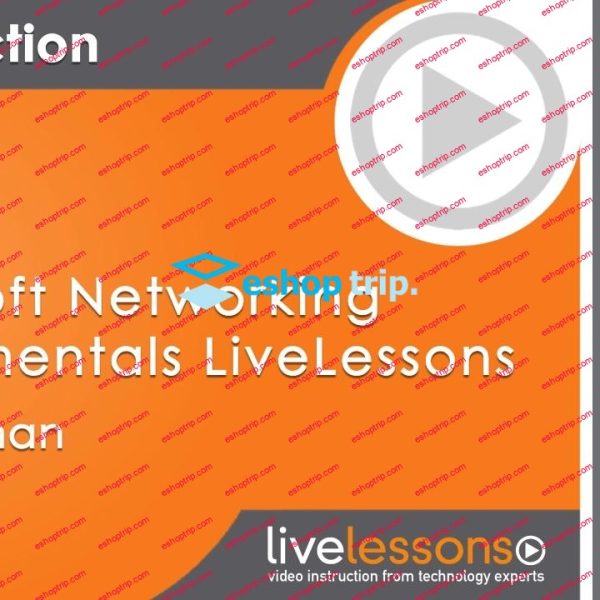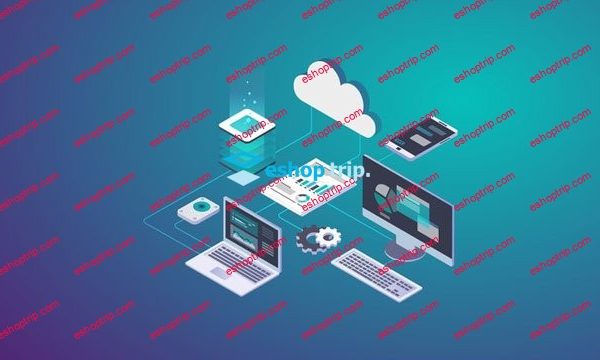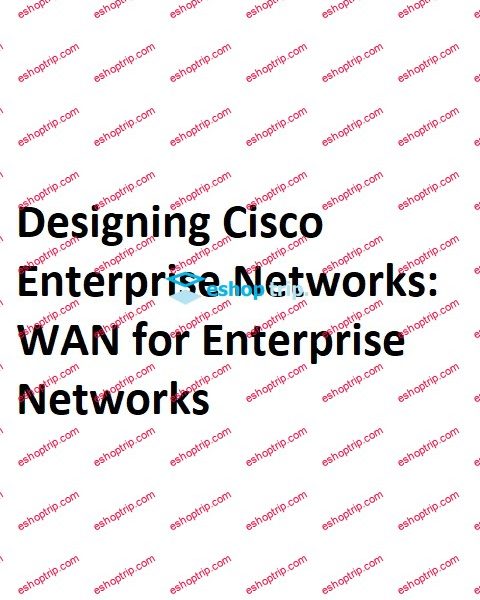Published 11/2024
Created by TechKnowSurge (Andrew Grimes)
MP4 | Video: h264, 1280×720 | Audio: AAC, 44.1 KHz, 2 Ch
Genre: eLearning | Language: English | Duration: 126 Lectures ( 13h 52m ) | Size: 15.2 GB
How to Implement and Manage Local Infrastructures
What you’ll learn
Explain VLANs, their purpose, and how to configure them
Explain VLAN Trunking Protocol and how it distributes VLANs across a switching domain
Create a VLAN Schema for a simulated company
Configure VLANs for a simulated company
Explain VLAN Trunking, 802.1q, and Inter-Switch Link (ISL)
Explain and configure native, data, and voice VLANs
Explain and configure Dynamic Trunking Protocol (DTP)
Apply VLAN trunking concepts and configurations to a simulated network
Practice troubleshooting various VLAN issues
Explain methods of implementing Inter-VLAN Routing
Configure Layer 3 Switching
Apply Layer 3 Switching concepts and configurations to a simulated network
Explain Spanning Tree Protocol and it’s components
Calculate the Root Bridge (RB), Root Ports (RP), Designated Ports (DP), and Non Designated Ports (NDP) for a given network
List STP versions and their differences
Explain and configure Port Fast, BPDU Guard, BPDU Filter, Root Guard, and Loop Guard
Configure STP settings for a simulated network
Explain and configure Link Aggregation/EtherChannels
Explain and configure LACP and PAgP
Apply Link Aggregation configurations to a simulated network
Explain and configure DHCPv4, SLAAC, and DHCPv6
Explain RA Flags and their role in configuration
Explain and configure a DHCP Relay and a DHCP Client Interface
Apply DHCP and SLAAC configurations to a simulated network
Explain and configure FHRP and HSRP
Explain different types of attacks and ways to mitigate against those attacks
Explain and configure mitigation techniques such as Port Security, DHCP Snooping, Dynamic ARP Inspection (DAI), IP Source Guard (IPSG), and BPDU Guard (BPDU)
Explain and configure Wireless Access Points (WAP) and a Wireless LAN Controllers (WLC) for a given network
Configure WLAN settings such as WPA2 PSK, DHCP, SNMP, and RADIUS for a given network
Requirements
Familiar with Cisco IOS
A strong understanding of Layer 2 and Layer 3 networking concepts
Description
This course provides an in-depth exploration of Virtual Local Area Networks (VLANs) and their role in modern network infrastructure. Students will learn to configure, manage, and troubleshoot VLANs and associated protocols, such as VLAN Trunking Protocol (VTP) and Dynamic Trunking Protocol (DTP). The course covers advanced topics like Inter-VLAN Routing, Layer 3 Switching, Spanning Tree Protocol (STP), and Link Aggregation, equipping students with the skills needed to design and implement efficient, secure, and scalable networks. Through practical simulations, students will apply these concepts to real-world scenarios, ensuring they are prepared to handle complex network environments. Additionally, the course will address critical security measures, including Port Security, DHCP Snooping, and Wireless LAN configuration, to protect network infrastructure from common threats.By the end of this course, students will be capable of designing and implementing comprehensive network solutions that incorporate advanced VLAN configurations, Layer 3 Switching, and robust security practices.Key components of the course include:Explain VLANs, their purpose, and how to configure themExplain VLAN Trunking Protocol and how it distributes VLANs across a switching domainCreate a VLAN Schema for a simulated companyConfigure VLANs for a simulated companyExplain VLAN Trunking, 802.1q, and Inter-Switch Link (ISL)Explain and configure native, data, and voice VLANsExplain and configure Dynamic Trunking Protocol (DTP)Apply VLAN trunking concepts and configurations to a simulated networkPractice troubleshooting various VLAN issuesExplain methods of implementing Inter-VLAN RoutingConfigure Layer 3 SwitchingApply Layer 3 Switching concepts and configurations to a simulated networkExplain Spanning Tree Protocol and it’s componentsCalculate the Root Bridge (RB), Root Ports (RP), Designated Ports (DP), and Non Designated Ports (NDP) for a given networkList STP versions and their differencesExplain and configure Port Fast, BPDU Guard, BPDU Filter, Root Guard, and Loop GuardConfigure STP settings for a simulated networkExplain and configure Link Aggregation/EtherChannelsExplain and configure LACP and PAgPApply Link Aggregation configurations to a simulated networkExplain and configure DHCPv4, SLAAC, and DHCPv6Explain RA Flags and their role in configurationExplain and configure a DHCP Relay and a DHCP Client InterfaceApply DHCP and SLAAC configurations to a simulated networkExplain and configure FHRP and HSRPExplain different types of attacks and ways to mitigate against those attacksExplain and configure mitigation techniques such as Port Security, DHCP Snooping, Dynamic ARP Inspection (DAI), IP Source Guard (IPSG), and BPDU Guard (BPDU)Explain and configure Wireless Access Points (WAP) and a Wireless LAN Controllers (WLC) for a given networkConfigure WLAN settings such as WPA2 PSK, DHCP, SNMP, and RADIUS for a given networkBecome efficient in planning and configuring local infrastructuresImplement technologies such as VLANs, STP, DHCP, and WLANsApply these concepts to an actual network you will be building throughout the courseLearn troubleshooting skills to help you efficiently overcome problemsLearn it Right, Learn it Well, and Reap the RewardsSpending the time now to fully understand how to set up LAN technologies will help you in the field and for studying more advanced topics.Who Should Take this Course:Those who are studying for the CCNA examThose who who want the skills to build local infrastructuresWhy take the course from me?Experience: I’ve been in the IT world since 2000, have a masters in computers, and over 20 industry standard certificationsKnow how to Teach: I was trained as an instructor by the USAF, have a bachelors in education, teaching since 1997, and well over 6,000 hours of classroom instruction time.I’ve been a hiring manager since 2010, I know what skill sets employers are looking for.TechKnowSurge’s Unique ApproachYour instructor has training and years of experience as an educator, as a technician, and as a leader. The course implements the following features:Microstep lectures and segmented videos that meters learning into bite size chunks. It also makes it easy to go back and review concepts when needed.Staged-Based Educational Model where information is covered multiple times in increasing amounts of complexity. The approach helps reinforce learning and creates a knowledge and skill set less likely to fade with time.Extensive coverage of topics to make sure topics are explained fullyWell-organized content. A tremendous amount of effort has been placed on what order content should be delivered to maximize learning and minimizing confusion.A focus on pedagogy. A funny name, but your instructor has a deep understanding of educational theory and what drives learning.Module overviews explaining what to expect for each module and sets a mindset for why the information is important to learn.Video intros, overviews, and summaries to explain the intention of each video, reinforce learning, and prepare you for success.High quality and engaging videos that use graphics, great explanations, and analogies to explain complex topics in an easy to understand way.Real world application. Step beyond just the theory. Your instructor has real world experience and will share that with you throughout the course.Employer insight, know what employers are looking for. Your instructor runs IT Departments and hires individuals just like you.This well organized course will has the following modules:Welcome and Getting Started: Prepare yourself for efficiently and successfully completing the course. You’ll get an overview of what the course is all about and what you should expect out of it.VLANs: This module introduces the core concepts of Virtual Local Area Networks (VLANs), including their purpose, benefits, and configuration. Students will learn how VLANs are used to segment networks for improved performance and security. The module also covers VLAN Trunking Protocol (VTP), explaining how it simplifies VLAN management by distributing VLAN configurations across a switching domain. By the end of this module, students will have a solid understanding of VLANs and VTP, along with the skills to configure them in a network environment.Project VLANs: In this module, students will apply their knowledge of VLANs to design and implement a VLAN schema for a simulated company. The module will guide students through the process of creating a structured VLAN schema tailored to the specific needs of the organization, ensuring optimal network segmentation and security. Once the schema is established, students will configure the VLANs on network devices, bringing the design to life in a simulated environment. This hands-on experience will reinforce best practices in VLAN planning, deployment, and management. By the end of this module, students will be proficient in both designing and configuring VLANs to meet organizational requirements.VLAN Trunking: This module delves into advanced VLAN concepts, focusing on VLAN trunking and the protocols that facilitate inter-switch communication. Students will learn about VLAN Trunking, including the 802.1q and Inter-Switch Link (ISL) standards, which are essential for carrying multiple VLANs across network links. The module also covers the configuration of native, data, and voice VLANs, ensuring that students can effectively manage traffic types on a network. Additionally, students will explore and configure the Dynamic Trunking Protocol (DTP), which automates the creation of trunk links between switches. Through practical exercises, students will gain the skills needed to configure and manage these advanced VLAN features in a network environment.Project VLAN Trunking and VLAN Troubleshooting: This module provides hands-on experience with VLAN trunking, allowing students to apply trunking concepts and configurations in a simulated network environment. Students will implement VLAN trunking across multiple switches, ensuring seamless communication between VLANs. The module also focuses on troubleshooting common VLAN issues, teaching students how to identify and resolve problems related to trunking, VLAN misconfigurations, and network connectivity. By the end of this module, students will be equipped with practical skills to deploy VLAN trunking effectively and troubleshoot any associated issues in a real-world network.Inter-VLAN Routing: This module explores the methods used to implement Inter-VLAN Routing, a critical process for enabling communication between different VLANs in a network. Students will learn about various techniques, including the use of Layer 3 switches and routers to route traffic between VLANs. The module also provides detailed instruction on configuring Layer 3 Switching, allowing students to combine routing and switching functions within a single device for increased network efficiency. Through practical exercises, students will gain the expertise needed to configure and optimize Layer 3 Switching for effective Inter-VLAN Routing in complex network environmentsProject Layer 3 Switch: In this module, students will put their knowledge of Layer 3 Switching into practice by applying these concepts and configurations within a simulated network environment. They will configure Layer 3 Switches to enable efficient Inter-VLAN Routing and optimize network performance. The module emphasizes real-world scenarios, providing students with the opportunity to design, implement, and troubleshoot Layer 3 Switching solutions. By the end of this module, students will be confident in deploying Layer 3 Switching configurations to enhance the functionality and scalability of a network.STP: This module provides a comprehensive overview of the Spanning Tree Protocol (STP), a vital protocol for preventing loops in network topologies. Students will learn about the key components of STP, including the Root Bridge (RB), Root Ports (RP), Designated Ports (DP), and Non-Designated Ports (NDP), and how to calculate these for a given network. The module also covers the different versions of STP, highlighting their unique features and use cases. Additionally, students will learn to configure advanced STP features such as Port Fast, BPDU Guard, BPDU Filter, Root Guard, and Loop Guard to enhance network stability and security. Through hands-on practice, students will configure STP settings in a simulated network, ensuring they are prepared to manage and optimize network performance in real-world environments.Link Aggregation: This module focuses on Link Aggregation and EtherChannels, essential techniques for increasing bandwidth and redundancy in network links. Students will learn about the concepts behind Link Aggregation and how to configure EtherChannels to combine multiple physical links into a single logical link. The module also covers the Link Aggregation Control Protocol (LACP) and the Port Aggregation Protocol (PAgP), explaining their roles in managing aggregated links. Through practical exercises, students will configure LACP and PAgP in a simulated network environment and apply Link Aggregation configurations to enhance network performance and reliability. By the end of this module, students will be adept at implementing and managing Link Aggregation in a variety of network scenarios.DHCP & SLAAC: This module provides a thorough understanding of dynamic IP address assignment in both IPv4 and IPv6 networks. Students will learn how to configure DHCPv4, Stateless Address Autoconfiguration (SLAAC), and DHCPv6 to automate IP address distribution. The module also explores Router Advertisement (RA) Flags and their role in IPv6 configuration, enabling students to fine-tune network settings. Additionally, students will learn how to configure a DHCP Relay and a DHCP Client Interface to extend DHCP services across networks. Practical exercises will allow students to apply these configurations in a simulated network, ensuring they can effectively manage IP address assignment in diverse network environments.HSRP: This module covers First Hop Redundancy Protocols (FHRP) with a focus on Hot Standby Router Protocol (HSRP), a key technology for ensuring network availability and reliability. Students will learn the principles behind FHRP, which provides high availability for the default gateway in a network. The module will delve into the configuration of HSRP, including setting up and managing virtual IP addresses and virtual MAC addresses to ensure seamless failover and redundancy. Through hands-on exercises, students will configure HSRP in a simulated network environment, gaining practical experience in implementing and troubleshooting FHRP to maintain network continuity and reliability.Layer 2 Security: This module provides an in-depth exploration of common network attacks and the strategies to mitigate them. Students will learn about various types of attacks, including Denial of Service (DoS), Man-in-the-Middle (MitM), and others, along with methods to defend against these threats. The module also covers critical network security techniques and their configurations, including Port Security, DHCP Snooping, Dynamic ARP Inspection (DAI), IP Source Guard (IPSG), and BPDU Guard (BPDU). Through practical exercises, students will configure these security features in a simulated network environment, gaining hands-on experience in protecting network infrastructure from potential vulnerabilities and ensuring robust security measures.WLAN: This module covers the configuration and management of Wireless Access Points (WAPs) and Wireless LAN Controllers (WLCs) to establish and maintain wireless networks. Students will learn to set up WAPs and WLCs to ensure optimal wireless coverage and performance. The module also includes detailed instructions on configuring Wireless LAN (WLAN) settings, including WPA2 PSK for security, DHCP for IP address assignment, SNMP for network management, and RADIUS for authentication. Through practical exercises, students will apply these configurations in a simulated network environment, developing the skills needed to effectively manage and secure wireless networks.Wrap Up: Time to wrap up the course and provide any final thoughts.Instructor BioTechKnowSurge (Andrew Grimes) has been in the tech industry since 2000 and even longer as an Instructor. He started out as a Survival Instructor for the United States Air Force (USAF) in 1997. When he got out of the military, he started teaching computer classes. Wanting to advance his technical skills, he became a contractor working on a wide range of technologies while teaching technology college courses in the evening. Overtime, he became a hiring manager, director, and leaderHis background includes:Building a security program within 2 years to include becoming SOC 2 Type 2 compliantLeading and maximizing efficiency of IT, Security, and DevOps teamsManaging SaaS company infrastructure with millions of active usersManaging small, medium, and large IT InfrastructuresMigrating technologies to the cloudManaging multi-million dollar budgets and reducing overall budget spend year over yearUtilizing various project management techniques such as waterfall, scrum and Kanban to maximize efficiency and successBachelors in Workforce EducationMasters in Computer Resource and Information ManagementOver 6,000 hours of teaching experienceOver 20 industry standard certifications.Past student reviews:“Andrew is absolutely the best instructor I’ve had throughout the course of my education. He is extremely knowledgeable when it comes to all things network and IT-related. Because of the education he provided, I am now working in the network engineering field, and I could not have done it without his expert guidance.” ~Michael B.“Andrew was hands down my favorite instructor since enrolling” “He has great skills as an instructor, and I’ve learned a lot from his classes.” ~Jeff S.“As an instructor, he is thorough, articulate, patient and positive. He genuinely cares that his students fully comprehend the curriculum. I have a great deal of respect for Andrew. I can’t recommend him highly enough.” ~Dan H.“I found Andrew to be one of the best Instructors” “He presents the information with real world applications, which helped to reinforce the concepts presented in the Cisco Certification track.” “I am truely thankful to have had him as my teacher.” ~Dan M.“Andrew is very knowledgeable and brings his practical business experience with him. He expresses himself very well and treats everyone with respect. He explains very complicated concepts in a manner that is easy to understand.” “It is without reservation that I would recommend Andrew as a business professional and/or teacher.” ~Adam C.“Andrew is an excellent instructor and more.” “Andrew is the kind of teacher that you never forget.” ~ William C.“Andrew Grimes is a first rate instructor who genuinely cares about the success of his students. I was fortunate to have Andrew as my instructor.” “I highly recommend Andrew as an instructor and IT professional.” ~Paul C.“Andrew is a great instructor who really cares whether his students grasp the concepts he teaches. He has a passion for teaching that many couldn’t muster.” ~Patrick R.“He was a great teacher and I would gladly take a class under him again.” ~Joshua R.“…his style of teaching is accommodating for any level, that a student is starting off at, either beginning or advance in IT world.” ~Paul W.“He fosters a multidimensional environment of learning in which students of diverse abilities excel.” ~Mark B“Andrew Grimes was a great Data Networks and Telecommunications Instructor.” “I would highly recommend him to any who desires to further their education.” ~ Tommy S
Who this course is for
Those who are studying for the CCNA exam
Those who who want the skills to build local infrastructures
https://anonymz.com/?https://www.udemy.com/course/managing-lans/










